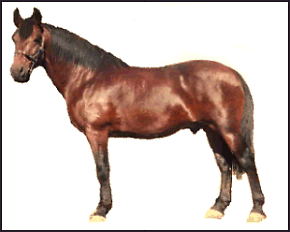
COMMON HORSE BREEDS
| CLEVELAND BAY
Origin: |
 Photo supplied by the Cleveland Bay Horse Society of Australia © |
History:
In medieval times in the north east of England bay coloured horses were bred for pack
work, which was the preferred way of transport of the travelling salesmen or chapmen. So
these horses were called Chapman horses. In the 17th century breeders crossed the Chapman
horses with imported Andalusian and Barb stallions to produce a fine coach horse, renown
for its stamina and active paces. The main breeding area was in Cleveland Bay and lent its
name to the breed.
With the introduction of motorised vehicles coach horses were no longer required. A small
number of Cleveland Bay horses survived and were crossed with the Thoroughbred to produce
a handsome, upstanding, heavyweight hunter and excellent carriage horse. The survival of
the breed was greatly helped by Queen Elizabeth II who bought a colt named Mulgrave
Supreme that was broken to saddle and harness and made available to breeders of pure-bred
and part-bred Cleveland Bay. Prince Philip drove teams of these horses in international
four-hand events. This led to new interest in the breed. There are approximately 500
Cleveland Bay horses world wide, mainly in Britain, North America, Japan, New
Zealand and Australia.
Characteristics:
Head: bold,
medium size head; well set, kind eyes; large, fine ears;
Neck: long, lean
Shoulders: deep, sloping,
muscular
Body: deep, wide body; strong,
muscular loins; powerful hindquarters
Legs: clean without feather; muscular forearms, thighs and second thighs; large
knees and hocks; strong, sloping pasterns
Feet: good, sound
Tail: well set
Color: bay with black points
Height: 16 to 16.2hh; height
does not disqualify a good horse
Temperament: kind
Qualities: straight, free
action; moves freely and covers the ground well; courage
Today:
The Cleveland Bay is well suited as a hunting and harness horse. Crossed with the
Thoroughbred the breed makes excellent show jumpers.
![]()